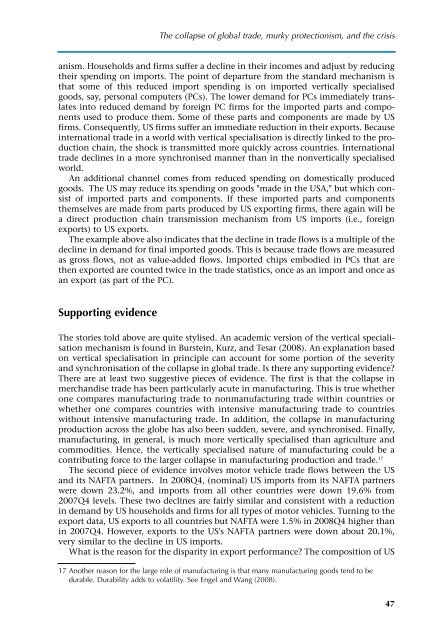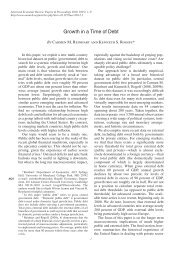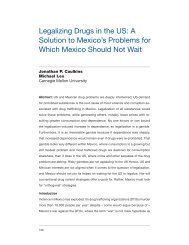The collapse of global trade, murky protectionism, and the crisis:
The collapse of global trade, murky protectionism, and the crisis:
The collapse of global trade, murky protectionism, and the crisis:
You also want an ePaper? Increase the reach of your titles
YUMPU automatically turns print PDFs into web optimized ePapers that Google loves.
<strong>The</strong> <strong>collapse</strong> <strong>of</strong> <strong>global</strong> <strong>trade</strong>, <strong>murky</strong> <strong>protectionism</strong>, <strong>and</strong> <strong>the</strong> <strong>crisis</strong><br />
anism. Households <strong>and</strong> firms suffer a decline in <strong>the</strong>ir incomes <strong>and</strong> adjust by reducing<br />
<strong>the</strong>ir spending on imports. <strong>The</strong> point <strong>of</strong> departure from <strong>the</strong> st<strong>and</strong>ard mechanism is<br />
that some <strong>of</strong> this reduced import spending is on imported vertically specialised<br />
goods, say, personal computers (PCs). <strong>The</strong> lower dem<strong>and</strong> for PCs immediately translates<br />
into reduced dem<strong>and</strong> by foreign PC firms for <strong>the</strong> imported parts <strong>and</strong> components<br />
used to produce <strong>the</strong>m. Some <strong>of</strong> <strong>the</strong>se parts <strong>and</strong> components are made by US<br />
firms. Consequently, US firms suffer an immediate reduction in <strong>the</strong>ir exports. Because<br />
international <strong>trade</strong> in a world with vertical specialisation is directly linked to <strong>the</strong> production<br />
chain, <strong>the</strong> shock is transmitted more quickly across countries. International<br />
<strong>trade</strong> declines in a more synchronised manner than in <strong>the</strong> nonvertically specialised<br />
world.<br />
An additional channel comes from reduced spending on domestically produced<br />
goods. <strong>The</strong> US may reduce its spending on goods "made in <strong>the</strong> USA," but which consist<br />
<strong>of</strong> imported parts <strong>and</strong> components. If <strong>the</strong>se imported parts <strong>and</strong> components<br />
<strong>the</strong>mselves are made from parts produced by US exporting firms, <strong>the</strong>re again will be<br />
a direct production chain transmission mechanism from US imports (i.e., foreign<br />
exports) to US exports.<br />
<strong>The</strong> example above also indicates that <strong>the</strong> decline in <strong>trade</strong> flows is a multiple <strong>of</strong> <strong>the</strong><br />
decline in dem<strong>and</strong> for final imported goods. This is because <strong>trade</strong> flows are measured<br />
as gross flows, not as value-added flows. Imported chips embodied in PCs that are<br />
<strong>the</strong>n exported are counted twice in <strong>the</strong> <strong>trade</strong> statistics, once as an import <strong>and</strong> once as<br />
an export (as part <strong>of</strong> <strong>the</strong> PC).<br />
Supporting evidence<br />
<strong>The</strong> stories told above are quite stylised. An academic version <strong>of</strong> <strong>the</strong> vertical specialisation<br />
mechanism is found in Burstein, Kurz, <strong>and</strong> Tesar (2008). An explanation based<br />
on vertical specialisation in principle can account for some portion <strong>of</strong> <strong>the</strong> severity<br />
<strong>and</strong> synchronisation <strong>of</strong> <strong>the</strong> <strong>collapse</strong> in <strong>global</strong> <strong>trade</strong>. Is <strong>the</strong>re any supporting evidence?<br />
<strong>The</strong>re are at least two suggestive pieces <strong>of</strong> evidence. <strong>The</strong> first is that <strong>the</strong> <strong>collapse</strong> in<br />
merch<strong>and</strong>ise <strong>trade</strong> has been particularly acute in manufacturing. This is true whe<strong>the</strong>r<br />
one compares manufacturing <strong>trade</strong> to nonmanufacturing <strong>trade</strong> within countries or<br />
whe<strong>the</strong>r one compares countries with intensive manufacturing <strong>trade</strong> to countries<br />
without intensive manufacturing <strong>trade</strong>. In addition, <strong>the</strong> <strong>collapse</strong> in manufacturing<br />
production across <strong>the</strong> globe has also been sudden, severe, <strong>and</strong> synchronised. Finally,<br />
manufacturing, in general, is much more vertically specialised than agriculture <strong>and</strong><br />
commodities. Hence, <strong>the</strong> vertically specialised nature <strong>of</strong> manufacturing could be a<br />
contributing force to <strong>the</strong> larger <strong>collapse</strong> in manufacturing production <strong>and</strong> <strong>trade</strong>. 17<br />
<strong>The</strong> second piece <strong>of</strong> evidence involves motor vehicle <strong>trade</strong> flows between <strong>the</strong> US<br />
<strong>and</strong> its NAFTA partners. In 2008Q4, (nominal) US imports from its NAFTA partners<br />
were down 23.2%, <strong>and</strong> imports from all o<strong>the</strong>r countries were down 19.6% from<br />
2007Q4 levels. <strong>The</strong>se two declines are fairly similar <strong>and</strong> consistent with a reduction<br />
in dem<strong>and</strong> by US households <strong>and</strong> firms for all types <strong>of</strong> motor vehicles. Turning to <strong>the</strong><br />
export data, US exports to all countries but NAFTA were 1.5% in 2008Q4 higher than<br />
in 2007Q4. However, exports to <strong>the</strong> US's NAFTA partners were down about 20.1%,<br />
very similar to <strong>the</strong> decline in US imports.<br />
What is <strong>the</strong> reason for <strong>the</strong> disparity in export performance? <strong>The</strong> composition <strong>of</strong> US<br />
17 Ano<strong>the</strong>r reason for <strong>the</strong> large role <strong>of</strong> manufacturing is that many manufacturing goods tend to be<br />
durable. Durability adds to volatility. See Engel <strong>and</strong> Wang (2008).<br />
47





